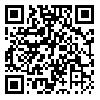Volume 5, Issue 1 (1-2018)
jbrms 2018, 5(1): 1-9 |
Back to browse issues page
Download citation:
BibTeX | RIS | EndNote | Medlars | ProCite | Reference Manager | RefWorks
Send citation to:



BibTeX | RIS | EndNote | Medlars | ProCite | Reference Manager | RefWorks
Send citation to:
Barzegari A A, Hashemzaei M, Alihemmati A, Soltani S, Naseri B. Effects of Lactobacillus rhamnosus (ATCC 7469) ointment on second-degree burn wound in Wistar rat . jbrms 2018; 5 (1) :1-9
URL: http://jbrms.medilam.ac.ir/article-1-348-en.html
URL: http://jbrms.medilam.ac.ir/article-1-348-en.html
Department of Biology, Faculty of Basic science, University of Maragheh, Maragheh, Iran , abarzegari@maragheh.ac.ir
Abstract: (6977 Views)
Introduction: Burn is among the traumas that impose great physical and psychological damages to the injured people. Scientists still are looking for new treatments and methods for burn management that lack the defects of previous ones. Recently, the potential of probiotic bacteria for the treatment of skin disease and problems has been investigated. Considering that the effects of probiotics are strain-dependent, the aim of current study was to evaluate the effects of Lactobacillus rhamnosus (ATCC 7469) on the process of burn wound healing.
Materials and methods: After induction of second-degree burn wounds on the back of rats, they were randomly divided into experimental, vehicle control, and negative control groups. The experimental groups received a bacterial ointment for 1, 3, 7, and 14 days. The vehicle control groups received Eucerin for durations like the experimental groups. The negative control groups received no treatment in the same days. The evaluation of wound healing was conducted macroscopically by computing of the healing percent and microscopically by Hematoxylin and Eosin staining of the tissue samples of the wound area on different days.
Results: The wound healing percent in the experimental group, compared with control groups, significantly increased, until the day 7 of the experiments. Moreover, the microscopic results indicate that the bacteria may have some anti-inflammatory effects. Also, the bacteria increased the rate of fibroblastic migration and re-epithelialization in the wound area.
Conclusion: Overall, L. rhamnosus (ATCC 7469) when used topically on the burn wounds may have some positive effects on the process of burn wound healing.
Materials and methods: After induction of second-degree burn wounds on the back of rats, they were randomly divided into experimental, vehicle control, and negative control groups. The experimental groups received a bacterial ointment for 1, 3, 7, and 14 days. The vehicle control groups received Eucerin for durations like the experimental groups. The negative control groups received no treatment in the same days. The evaluation of wound healing was conducted macroscopically by computing of the healing percent and microscopically by Hematoxylin and Eosin staining of the tissue samples of the wound area on different days.
Results: The wound healing percent in the experimental group, compared with control groups, significantly increased, until the day 7 of the experiments. Moreover, the microscopic results indicate that the bacteria may have some anti-inflammatory effects. Also, the bacteria increased the rate of fibroblastic migration and re-epithelialization in the wound area.
Type of Study: Research |
Subject:
Microbiology
Received: 2017/09/6 | Accepted: 2017/11/5 | Published: 2017/12/6
Received: 2017/09/6 | Accepted: 2017/11/5 | Published: 2017/12/6
Send email to the article author
| Rights and permissions | |
 |
This work is licensed under a Creative Commons Attribution-NonCommercial 4.0 International License. |






